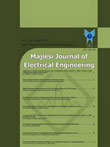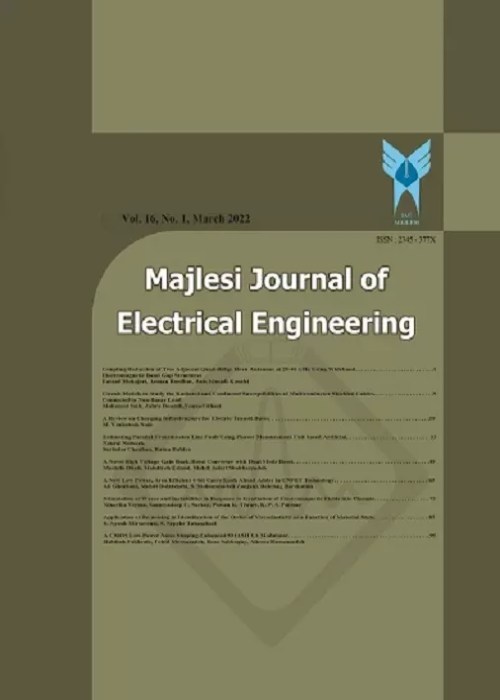فهرست مطالب

Majlesi Journal of Electrical Engineering
Volume:10 Issue: 4, Dec 2016
- تاریخ انتشار: 1395/10/11
- تعداد عناوین: 7
-
-
Page 1This paper proposes the improved group search optimization algorithm for optimal reactive power dispatch (ORPD). The ORPD problem is a non-linear, non-convex optimization problem which has various decision variables such as the compensation capacitors proportions, voltages of generators and the tap position of tap changing transformers. In this paper the multi-objective ORPD considering loss and voltage deviation is studied. Due to complicating objectives and also physical and operating constraints, an efficient optimization algorithm is needed. This paper solves the mentioned problem by using the group search optimization algorithm (GSO) which is one of the novel presented optimization algorithms based on group living and especially searching behavior of animals. In order to improve the algorithm efficiencies, the improved group search optimization algorithm (IGSO) is proposed. Accordingly, the algorithm would obtain better result due to its ability to find the global optimal rather than local ones. Additionally, the penalty factor approach is used in order to solve the multi-objective case.Keywords: Optimal reactive power dispatch, Multi, objective optimization, Group search optimization, Voltage deviation
-
Page 11Anti-lock braking system is designed to optimize braking procedure while maintaining automobile steerability through controlling wheels slip. However, due to nonlinearity and uncertainty of ABS structure, designing the controller for wheel slip encounters so many problems which necessitate a robust control system. In this paper a hybrid controller is proposed for ABS to address this issue. The designed controller is a combination of sliding mode control and fuzzy control. In fact, the fuzzy system determines switching factor of sliding mode controller proportional to automobile speed employing fuzzy rules. In this way, it would be able to avoid braking command fluctuations in lower speeds. Simulations are performed in ¼ model of automobile in MATLAB environment. The simulation results revealed the capability of proposed system to maintain slip ratio in optimal value as well as avoiding braking fluctuations in low speeds.Keywords: Anti, lock braking system (ABS), Sliding mode control, Fuzzy control
-
Page 17In order to analyze the mathematical modeling and PID controller performance of a quadrotor, this paper firstly, describes the quadrotor flight dynamics according to Newton-Euler laws, then equations of motion linearized and transfer functions for 6 degree of freedom obtained in state space domain. Classic PID controller based on Ziegler-Nichols method is designed and implemented on system. In order to have better performance, Genetic Algorithm based on step response optimization, is used to optimize PID controller performance and compared with classic method. Finally, step responses comparison for each transfer functions, showed that Genetic Algorithm with PID control synthesis presents better efficiency than the classic PID controller.Keywords: Quadrotor, PID controller, Ziegler, Nichols, 6 degree of freedom, Genetic Algorithm
-
Page 25In this paper a new control strategy for dynamic voltage restorer (DVR) is presented to compensate effectively voltage sags. In this strategy, load and supply voltage magnitude and angle are estimated by least error square in short time. Advantage of this method is reducing noise, distortion and harmonic on estimation parameters. Accordingly, these parameters are controlled for each phase separately. Also, it should be noted that due to angle estimation by LES filters, control system does not require phase-locked Loop and this issue causes increase in speed of control system response. In addition, a P䗫⢝ꧭ and Posicast controller are used to eliminate the steady-state error and improve transient response in DVR, respectively. The proposed control system is simulated, using PSCAD/EMTDC software by induction motors starting is connected to 13 bus IEEE standard network. Finally, the simulation results prove that the proposed control scheme performs satisfactorily under sudden changes of load.Keywords: Dynamic voltage restorer, Voltage sag, Least error squares filters, Control system, Power quality
-
Page 33The purpose of this study is flattening the amplified spontaneous emission (ASE) spectrum based on an erbium-doped fiber (EDF) by using a standard fiber-based loop mirror (FLM) and tapered fiber. Subsequently, an over-coupled coupler is fabricated to realize the FLM, which is integrated to an EDF pumped by a 980-nm laser diode with a power level of 100 mW. By introducing an appropriate amount of bend-induced and inserting the optical tapered fiber in FLM, the ASE spectrum of the EDF was flattened within 0.9 dB over a wavelength range of 31 nm in the C-band (1525 nm-1556 nm).Keywords: ASE source, Erbium, Doped Fiber Amplifier (EDFA), Fiber Loop Mirror (FLM), Gain, flattening spectrum, Optical taper Fiber
-
Page 39Data mining has been used as a public utility in extracting knowledge from databases during recent years. Developments in data mining and availability of data and private information are the biggest challenge in this regard. Privacy preserving data mining is a response to this big challenge. The main purpose of techniques and algorithms in privacy preserving data mining is non-disclosure of sensitive and private data with minimum changes in databases so that it would not have adverse effects on the rest of data. The present paper intends to present a brief review of methods and techniques regarding privacy of data mining in association rules, their classification and finally, classification of hiding algorithms of association rules followed by a comparison between a numbers of these algorithms.Keywords: Privacy Preserving Data Mining, Association Rule, Sensitive Data, Data Disclosure
-
A New Meta-Heuristic Algorithm for Optimization Based on Variance Reduction of Gaussian DistributionPage 49Meta-heuristic methods are global optimization algorithms which are widely used in the engineering issues, nowadays. In this paper, a new stochastic search for optimization is presented using variable variance Gaussian distribution sampling. The main idea in searching for algorithm is to regenerate new samples around each solution with a Guassian distribution. Numerical simulations have revealed that the new presented algorithm outperformed some evolutionary algorithms.Keywords: Optimization, Gaussian distribution, Covariance matrix, Stochastic search, Variance reduction, Probability Density Function (PDF, hereafter)


